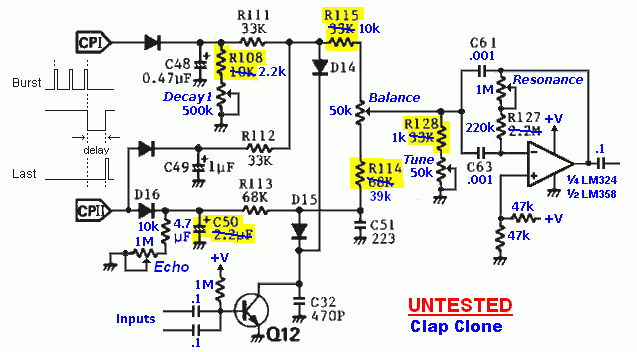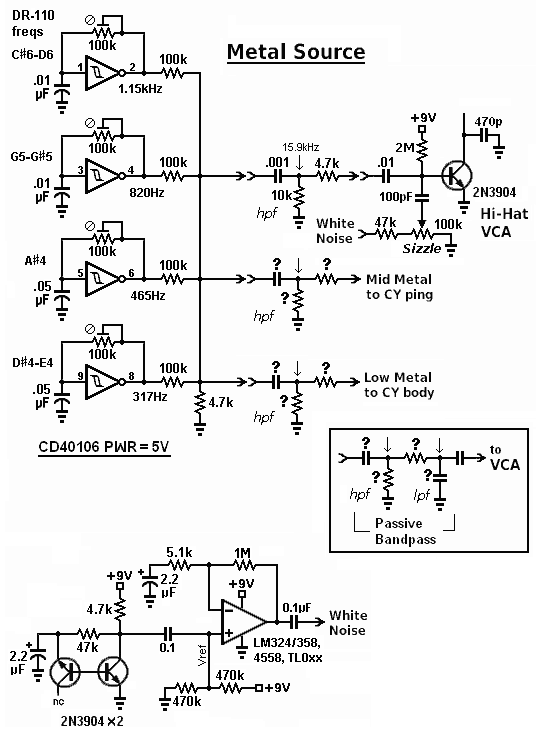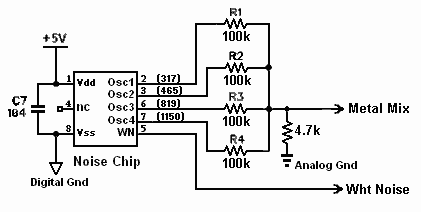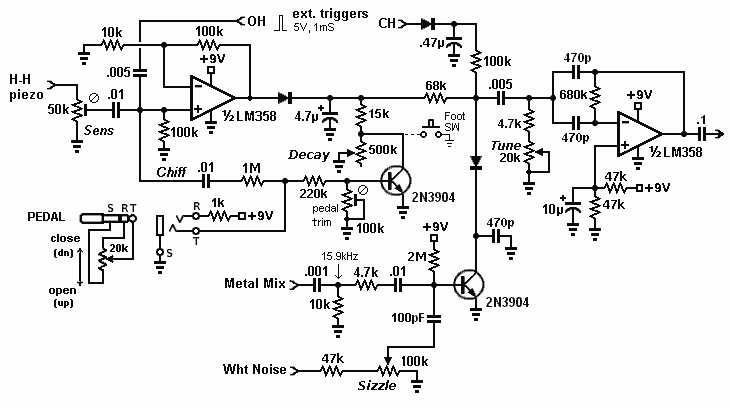Hand Clap CloneLike the Hi-Hat and Cymbal, the Clap can be cloned by simply copying the original and adding the published modifications. There are other possibilities.Also like the HH and Cymbal, if positive triggers are available the inverting PNP transistors can be omitted. The decay of each of the burst envelopes can be controlled by putting a resistor and pot in parallel with C48. I would not control the delayed, echo decay by varying R113, as one mod suggests, but instead increase C50, with a resistor and pot in parallel. (The same could be done, I suppose, at C49, but that might be one knob too many.) Instead of separate pots for R114 and R115, I'd have a balance pot to vary the relative levels of the burst and delayed signals.
 I'd change the output filter to the one shown above, which is, incidentally, the same Inifinite Gain Multiple Feedback *band pass filter as the original transistor version. I like the op amp better. Lastly, I'd bias Q12's base and capacitor couple to it so that sources other than noise could be used By making Decay1 long enough and Echo short, the output could sound like Maracas. With "Metal" instead of noise as input, a Tambourine might be possible. Make Decay1 so long that the three triggers lose their separateness, producing one longer decay envelope, and the result could be another cymbal. Of course, all this speculation won't amount to much without a source of suitable triggers, and there are two ways to get them: thru software or hardware. The former method could be done with an Arduino, PIC(axe) or even a Basic Stamp. The hardware method I have in mind would need only two ICs, but I don't want to say anymore about that until I actually try it. *Some references say it's a high pass. Regardless, I just like how it sounds. MY Successful Partly Cloned Hi-Hat(Updated Dec., 2012) I changed the "Metal" filtering as described in the next section. Briefly, instead of sending the mix of 4 oscillators to two resonant low pass filters, I used a simple passive cap and resistor hi-pass for the Hi-Hat VCA input. White noise was *digitally generated at 5V logic levels, but a 2-transistor circuit would provide a more than high enough noise level when powered by 9V.In my first attempt I omitted the Closed trigger E.G, because my primary interest is playing by hitting pads with sticks, with electronic triggering as a future option, and relied solely on a foot pedal to control Decay. Realizing that would be a limitation if a sequencer was doing the playing, I added a Decay pot to the "main", Open E.G., and a simple short, Close decay E.G. that doesn't have the elegant interaction with Q4 that the original '110 circuit has.
Pedal control of Decay could be accomplished with a simple foot switch in parallel with the Decay pot. But I want more control over decay than fully Open or completely Closed, so a transistor (Q4 in the original '110 schematic,) does that via voltage from a continuous pedal. As a refinement, the pedal voltage is also routed to the piezo amplfier input by a resistor and capacitor. The effect of this is that if the pedal is pressed smoothly, the voltage causes the transistor to conduct and shortens the Open decay by variable amounts. If, however, the pedal is pressed rapidly the resulting voltage change briefly "jumps" across the cap, creating a low level trigger, which in turn produces the sound of closing the 'Hat without striking it. (Called "Chiff" in drummer's jargon.) The faster (more vigorously,) the pedal is pressed, the louder the Chiff produced, as can be heard in the sample. What can also be heard is what's called Pedal Splash, the technique of rapidly closing the 'Hat then quickly opening it to let the top and bottom cymbals freely vibrate. I'm not skilled enough to achieve that effect consistently, but I've been practicing.
Comparison, DR-110 Open -vs- mine. Open triggers with foot-switch Closed. The output hi-pass filter provides a respectable range of tonality, from high and thin to low and clanky, not sounding at all like a Hi-Hat -- especially when no white noise is present. Filtering, with noise and without Admittedly, the circuit isn't much of a clone anymore; all that remains of the original design is the transistor VCA and the metal oscillators' frequencies.
Alternative Metal FilteringI reasoned that starting with the oscillators mix at a higher amplitude than in the '110, passive filters would do the job of splitting the Metal Mix into bands, and their inherent losses would reduce the signal to levels that wouldn't overdrive the simple 1-transistor VCAs. An active filter at the output of each voice would further refine the frequency spectra.I increased the resistor to ground in the passive, resistor mixer from 560 ohms to 1k, then to 4.7k. For the Hi-Hat this higher-level mix went to an R-C hi-pass with values that sounded "right" to me. The 4.7k in series with this hpf prevents the Sizzle (White Noise,) setting from getting into other voices that might have their own Sizzle setting. The cap at the transistor VCA collector removes the highest high frequencies and the output filter further defines the tone of the instrument.
 Cymbal ping and body can be processed in the same manner. Note, however, that the Metal ranges for these sounds can be more thoroughly limited with a passive band-pass, formed by a hi-pass followed by a low-pass. I don't show any resistor and capacitor values for Ping and Body because I haven't gotten that far, yet. Tests using '808, '606 and '110 cymbal samples and Winamp's graphic equalizer suggest that Ping should be in the range of 4kHz - 10kHz and Body 800Hz - 3kHz. (Approximately.) Here's an online calculator that does all the work of finding the right R-C values; R-C Filter Cutoff And here is a Signal Generator (Windows only,) useful for tuning your oscillators. If anyone tries any of this stuff, do please let me know at the address at the bottom right of this page. *Full DisclosureAlthough I have confirmed that the four schmitt oscillator scheme depicted above does provide the correct combination of frequencies for "metal", that's not what I used in the Successful HiHat: I used a pre-programmed PIC that generates 4 square waves plus White Noise, eliminating a significant number of components. This PIC is used in the Delptronics LDB-1 Analog Drum Machine, a pretty cool -- and compact! -- little drum sequencer. (Check it out!) The Metal-Noise PIC is $4 each plus $2 shipping to the US. Contact Mickey Delp to inquire regarding availability. Check out his other products/projects while you're there.
|

 softhome.net
softhome.net